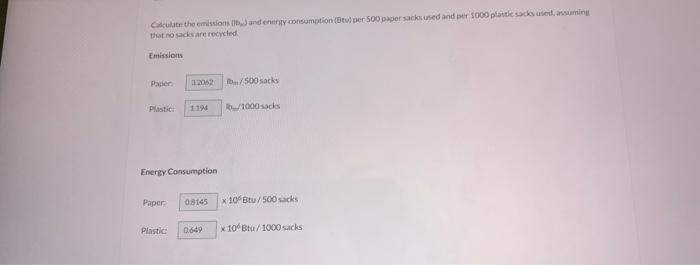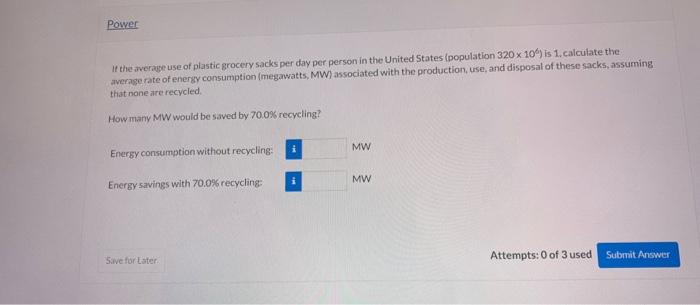Answered step by step
Verified Expert Solution
Question
1 Approved Answer
please help me with this problem. its different numbers than other questions posted in chegg so please do not copy from previously solve question on
please help me with this problem. its different numbers than other questions posted in chegg so please do not copy from previously solve question on chegg. i also posted the correct numbers for question 1 to help doing reduction. i will upvote thank you. 



A simplified version of the life cycle of grocery sacks follows. Acquisition Sack poction Disposal Recycled was In the late 1970s, supermarkets began to replace paper sacks with polyethylene (plastic) sacks. a In the 1980s, a movement to go back to paper arose, primarily inspired by environmental considerations. In the 1990s, a countermovement arose, claiming that paper sacks have a greater negative environmental impact than plastic ones. Following are estimates of the atmospheric emissions and energy consumption associated with the raw materials acquisition and processing (logging, pulping, and papermaking for paper, petroleum production and refining and polymerization for polyethylene) and disposal of sacks, and for the manufacture and use of sacks, Emissions oz/sack) Energy Consumed (Btu/sack) Stages Paper Plastic Paper Plastic Raw materials production plus product disposal 0.0510 0.0045 724 185 Sack production and use 0.0516 0.0146905 464 Cette the emissions and energy consumption (Btu) per 500 paper sacks used and per 1000 plastic sau asuming that no acids are recycled Emissions Papier 12062 b/500 sacks Plastic 1194 1000 sacs Energy Consumption Paper 08145 x 10 Btu/500 sacks Plastic 0649 x 10 Btu/1000 sacks Calculate the emissions (bn) and energy consumption (Btu) per 500 paper sacks used and per 1000 plastic sacks used assuming that 70.0% of the sacks are recycled By what percentages are emissions and energy consumption reduced for each sack material as a consequence of recycling? Emissions i % reduction Paper: 2728 14.91 Ib.../500 sacks Plastic reduction 1b/1000 sacks Energy Consumption 0.7059 * 10 Btu/500 sacks i Paper: % reduction 1333 Plastic: * 10 Btu/1000 sacks % reduction Power if the average use of plastic grocery sacks per day per person in the United States (population 320 x 10') is 1. calculate the average rate of energy consumption (megawatts, MW) associated with the production, use, and disposal of these sacks, assuming that none are recycled How many MW would be saved by 70.0% recycling? MW Energy consumption without recycling MW Energy savings with 70.0% recycling: Salve for Later Attempts: 0 of 3 used Submit 



Step by Step Solution
There are 3 Steps involved in it
Step: 1

Get Instant Access to Expert-Tailored Solutions
See step-by-step solutions with expert insights and AI powered tools for academic success
Step: 2

Step: 3

Ace Your Homework with AI
Get the answers you need in no time with our AI-driven, step-by-step assistance
Get Started


